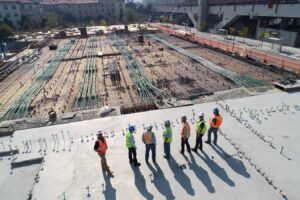
Here at MSC Safety Solutions, we understand the critical importance of fall protection in the construction and maintenance industries, especially when it comes to working on roofs. Fall-related accidents remain a leading cause of injuries and fatalities on worksites, and proper fall protection is not just a regulatory requirement but a life-saving necessity. For anyone working at height, especially on roofs, the right safety solutions and training are paramount.
In this blog, we’ll explore various fall protection options that workers can use on roofs, from personal protective equipment to engineered systems, as well as the regulations and best practices that help safeguard lives.
- Understanding the Risks of Roof Work
Roof work poses inherent dangers due to several factors, including the height of the work, the potential for sudden weather changes, and often unstable surfaces. Workers face risks such as:
- Slippery surfaces caused by rain, ice, or debris.
- Steep slopes, which make balance and stability more difficult.
- Unprotected edges, skylights, or fragile surfaces, which increase the risk of falling through.
These dangers make fall protection a priority for both workers and employers. OSHA has established clear guidelines to protect workers from fall-related injuries. Any fall from a height of 6 feet or more requires fall protection, according to OSHA standards.
- Types of Fall Protection for Roof Work
There are a variety of fall protection systems that can be used on roofs. Depending on the type of roof, job, and conditions, different solutions may be more appropriate. Let’s take a closer look at the most common options available to workers:
- Personal Fall Arrest Systems (PFAS)
Personal fall arrest systems are among the most common fall protection options for roof workers. These systems include a full-body harness, lanyard, and anchor point. When properly used, PFAS are designed to stop a worker’s fall and minimize injury.
- Anchorage points: The anchor must be securely fastened and capable of supporting the required load.
- Full-body harness: This distributes the force of the fall evenly across the body.
- Shock-absorbing lanyard: The lanyard helps reduce the forces transmitted to the worker during a fall.
- Guardrails and Edge Protection
Guard rails are an excellent solution for low-slope roofs. They provide a physical barrier along the roof’s edge, preventing workers from accidentally stepping off or tripping over the edge. OSHA prefers passive systems like guardrails because they do not require active engagement by the worker.
- Warning Line Systems
For low-slope roofs, warning line systems can be installed 6 feet from the edge. These lines are visible markers that alert workers when they are near an unprotected edge. They are often used in conjunction with other fall protection systems, such as guardrails or PFAS.
- Safety Net Systems
Safety nets are designed to catch workers if they fall. While less common in roofing work, they are sometimes used in situations where other fall protection methods are not feasible. Safety nets are positioned below the work area and are a secondary measure to reduce fall-related injuries.
- Roofing Brackets and Temporary Scaffolding
Roofing brackets and temporary scaffolding systems can also provide secure platforms for workers, offering both stability and fall protection. This equipment is particularly useful on steep roofs, where balance can be more difficult to maintain.
- Choosing the Right Fall Protection System
The choice of fall protection system depends on several factors:
- Type of roof: Flat roofs, steep roofs, and fragile surfaces all require different approaches.
- Type of work: Maintenance, installation, or demolition may require distinct fall protection methods.
- Weather conditions: Wind, rain, and ice can create additional hazards that need to be accounted for.
- Duration of the job: For short-term jobs, personal fall arrest systems may be sufficient, while longer-term projects may justify installing guardrails or scaffolding.
At MSC Safety Solutions, we emphasize that choosing the right system is only part of the equation. Proper training on the use and inspection of fall protection equipment is critical. Workers must be familiar with their fall protection systems and confident in using them correctly to ensure maximum safety.
- OSHA Guidelines and Compliance
OSHA’s guidelines for fall protection on roofs are clear. Employers must provide fall protection for employees working at heights of 6 feet or more. For roofing work, this may mean installing guardrails, using PFAS, or employing other suitable methods. Failure to comply with these guidelines can result in costly fines, but more importantly, it increases the risk of serious injury or death.
- Training and Education
At MSC Safety Solutions, we specialize in providing comprehensive fall protection training, tailored to the specific needs of roof workers. From proper use of PFAS to understanding OSHA requirements, we ensure that workers not only have the right equipment but the knowledge to use it effectively.
We believe that with the proper systems in place, fall-related accidents on roofs can be prevented. Our mission is to provide practical safety solutions that protect workers while allowing them to perform their jobs efficiently and confidently.
Fall protection is essential for anyone working on roofs. Whether through personal fall arrest systems, guardrails, or other safety measures, preventing falls is not only a legal requirement but a moral obligation. At MSC Safety Solutions, we are dedicated to helping businesses create safer work environments through innovative safety solutions, training, and compliance with OSHA regulations.
If your team needs assistance in evaluating fall hazards or implementing safety solutions for roofing work, contact MSC Safety Solutions today. Together, we can build a safer future.







